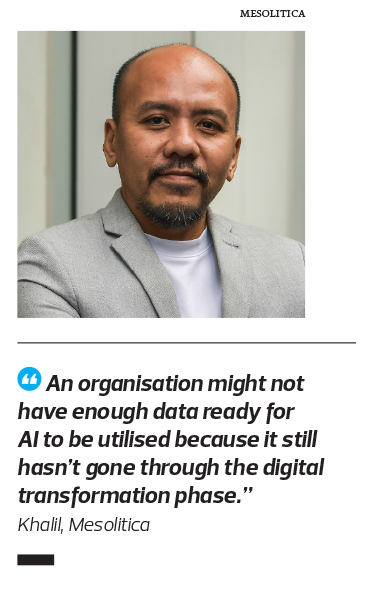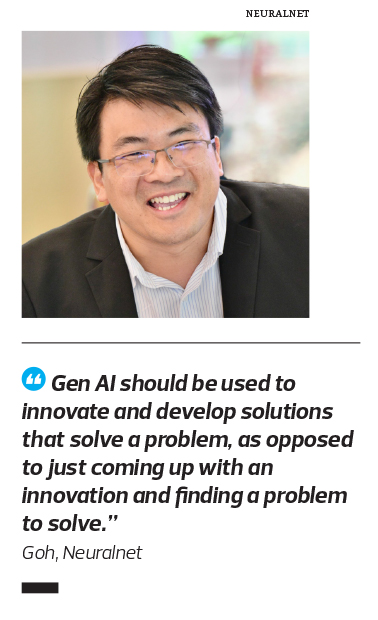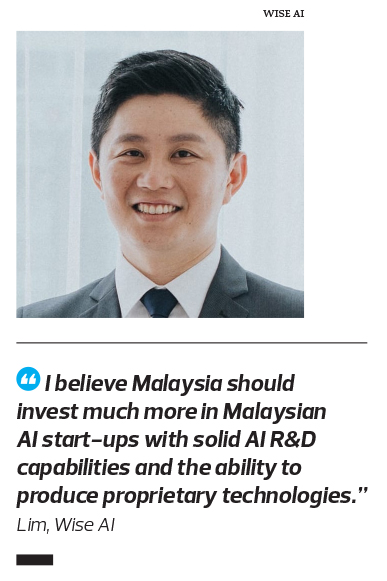
This article first appeared in Digital Edge, The Edge Malaysia Weekly on December 30, 2024 - January 12, 2025
Discussions about artificial intelligence (AI) and generative AI (Gen AI) often raise more questions than answers. Questions like “Is the AI investment bubble about to burst?”, “Is the market headed for a technological correction?” and “Will AI really lead to job losses?” are top of mind, especially as the technology advances at lightning speed.
Despite these uncertainties, it is undeniable that Gen AI holds transformational potential. Its impact on areas such as content discovery, creation, authenticity, regulation, automation, and both customer and employee experiences, could be profound.
However, many local industries are still exploring how to build a compelling business case for Gen AI. They are focusing on establishing foundational capabilities — such as undergoing digital transformation and collecting high-quality data — which are essential for leveraging AI effectively. According to NTT Data’s report, “Global GenAI Report: How organizations are mastering their GenAI destiny in 2025”, 98% of respondents in Malaysia identified legacy infrastructure as a significant barrier to using Gen AI effectively.
“Even if management wants AI to be adopted in an organisation very deeply, there is still the issue about big data. An organisation might not have enough data ready for AI to be utilised because it still hasn’t gone through the digital transformation phase,” says Khalil Nooh, co-founder and CEO of Mesolitica and one of the members of the Malaysia Artificial Intelligence Consortium (MAIC).
“That means some big tenders to upgrade systems need to include AI into the whole conversation. One conversation is: Do you already have a real-time pipeline for your data for this AI to consume? If not, then that entire data challenge has to be addressed first before we can apply AI.”
This conundrum positions Malaysia as an attractive market for Gen AI players, offering a unique opportunity to identify industry needs and develop tailored AI products and solutions that address them effectively.
An example is Neuralnet Technology Sdn Bhd, an AI and data science firm focused on AI-scoring solutions for enterprises to manage their workforce. Founded less than six months ago by Kevin Goh, a former senior design engineer who spent seven years in Austria, the company aims to address specific industry needs within Malaysia.
Goh chose to return to Malaysia to establish the company, citing greater opportunities to develop solutions locally compared with overseas.
“When I came back [to Malaysia], I saw a huge opportunity because there are not many Gen AI players in the country. I spoke to many company owners here to try and find opportunities through the pain points they have,” says Goh, Neuralnet’s director.
“Our clients were already thinking of how to leverage AI to manage their workforce and I would say we were considered lucky because as soon as we started, we had clients ready for us. When it comes to technology adoption, Malaysians are more open but when it comes to research and development (R&D), that is Malaysia’s weak point.”
According to Kuala Lumour-based business management consultant Gartner, while Gen AI has garnered significant attention, it has yet to deliver its anticipated business value for most organisations.
This trend is evident in Malaysia as well. The NTT Data report “Global GenAI Report” reveals that although eight in 10 organisations have a well-defined Gen AI strategy, many have not aligned it with their broader business plans, hindering return on investment.
Gen AI also faces challenges such as ethical concerns, the absence of established best practices, and malicious uses like deepfakes spreading disinformation. Additionally, both individuals and enterprises struggle to apply Gen AI beyond large language models (LLMs) like ChatGPT and Gemini, indicating a need for a broader understanding and application of its capabilities.
These challenges make it difficult for Gen AI companies to not only persuade other businesses to adopt AI but also to effectively bring their products to market. To succeed, these companies must focus on developing solutions that address the specific pain points faced by industries.
“A lot of AI innovators die in the cradle because they couldn’t find real applications [for their solutions]. We have the technology but there are no real, innovative use cases to address problems in the market, making the solutions ineffective. In other words, Gen AI should be used to innovate and develop solutions that solve a problem, as opposed to just coming up with an innovation and finding a problem to solve,” says Goh.
Talent is another area that needs some focus, which David Lim, CEO of enterprise AI solutions firm Wise AI, says “we need to do a lot more work in”. AI is not entirely about programming but involves advanced mathematical skills like linear algebra, probability and calculus.
“Malaysia’s initial science, technology, engineering and mathematics target was to achieve 60% in science and 40% in the arts stream.
“Nonetheless, it’s the other way around now. In this regard, Malaysia should also focus on training Technical and Vocational Education and Training talents on AI tools as most industries need talents who can use AI tools rather than develop new AI technologies.”
Business case needed to develop niche solution
So, what will separate the winners from the losers in the Gen AI space? Ultimately, it boils down to the revenue generated from their Gen AI solutions. According to Mesolitica’s Khalil, the company’s revenue currently does not come from its Bahasa Malaysia Gen AI large language model, MaLLaM, but instead from consultation services.
“Our consultation is LLM-related, where we also build custom solutions for clients. To continue [the LLM’s R&D], we are bootstrapping because it’s something that we cannot scale now. Venture capitalists (VC) want to invest in software and applications that are scalable for a big market,” he explains.
“But VCs will really look into [companies’] recurring revenue and churn rate because they want to see if you are able to retain customers for the long haul. I myself go back and forth between using different LLMs and similarly, Gen AI companies in Malaysia will have to contend with the same issue of keeping customers on the platform.
Mesolitica is a local start-up specialising in training LLMs. It has built a Malaysian language generative Gen AI LLM — MaLLaM LLM — on Amazon Web Services (AWS) cloud that can understand local nuances like slang, colloquialisms that merge different dialects, Bahasa Melayu, and 16 other regional languages for use in AI assistants across industries.
AI-assistants built on MaLLaM can provide quick, accurate responses to inquiries in multiple languages, including dialects from various Malaysian states such as Johor, Kedah, Sarawak, Selangor and Terengganu.
Policies to catalyse adoption
Considering the different layers of challenges for Gen AI players to enter the local market, why are Gen AI companies still betting on Malaysia as a place to grow this technology? According to the e-Conomy SEA 2024 report by Google, Temasek and Bain & Co, the regional digital economy has achieved profitability in just two years — 2.5 times from US$4 billion in 2022 to US$11 billion in 2024. This underscores the region’s capacity to not only embrace innovation but to translate it into tangible economic gains, delivering a 10-time increase in revenue since 2016.
The Malaysian government has been working on building trust between AI developers, users and policymakers. In September 2024, the Ministry of Science, Technology and Innovation (Mosti) launched the Malaysia AI Governance and Ethics (AIGE) framework, making us the first developing nation in Asean to introduce a national AI ethics framework for responsible development and use of AI technologies.
Wise AI’s proprietary electronic know-your-customer (e-KYC) solution was selected as the national AI ethics use case under the Malaysia AIGE.
Opportunity often follows wealth, says Wise AI’s Lim. The top six Southeast Asian economies are projected to grow at an annual rate of 5.1% between 2024 and 2034, according to a report by Bain & Co, and these countries are estimated to outpace China’s gross domestic product (GDP) growth rate and foreign direct investment (FDI).
This also means that AI tools will be widely adopted across industries, with potential AI-led economic benefits estimated at US$115 billion for Malaysia and US$1 trillion for the entire region.
“Global players are coming to the country to build data centres, which are the foundation for powering AI services. Malaysia benefits from AI infrastructure investments due to its affordable energy and land prices, agile and multilingual workforce, and business-friendly environment compared with traditional established data centre markets like Japan, Singapore and Hong Kong,” says Wise AI’s Lim.
Time to take risks and invest in R&D
Typically, Malaysians are hesitant to invest in R&D, as most companies tend to avoid risk and prioritise investment decisions based on carefully evaluating the return on investment (ROI). “If they don’t see the upper hand, they won’t invest. That’s the difference, if you compare Malaysia to Europe or the US. They are naturally risk takers and that is why innovation typically comes from the West,” says Goh.
A total investment of RM85.7 billion in R&D is required to achieve the targets set by the National Science, Technology and Innovation Policy (NSTIP) 2021-2030, according to Mosti.
The policy aims to increase the gross domestic expenditure on R&D (GERD) to 2.5% of GDP by 2025 and 3.5% by 2030. Based on projections, the estimated R&D spending needed is RM25.7 billion from the public sector and RM60 billion from the private sector to hit the 2030 target.
But it cannot be denied that funding drives R&D, which subsequently drives innovation, and currently, Malaysia’s R&D expenditure is only 1% of the country’s GDP. This significantly lags behind South Korea’s allocation of nearly 5.2% of its GDP in 2022 and China’s investment of 2.65% of its GDP in 2023.
However, this does not mean Malaysia should simply replicate the strategies of other nations. Instead, the focus should be on identifying niche markets that offer the highest returns on project outcomes and investment tailored to Malaysia’s unique strengths and opportunities.
“I believe Malaysia should invest much more in Malaysian AI start-ups with solid AI R&D capabilities and the ability to produce proprietary technologies. An AI start-up’s value lies in its flexibility to scale fast, and owning its intellectual properties definitely helps in terms of distribution, control, costing, company valuation and protection over investment,” says Wise AI’s Lim.
“Funding should go into recruiting world-class AI talents and returning expert programmes, providing long-term research funding for cutting-edge projects and helping train the next generation of AI researchers in Malaysia. Universities should also focus funding on R&D projects that can be commercialised.”
It is also important to work with the right VC, says Mesolitica’s Khalil, and when it comes to funding Gen AI applications, it is pertinent to find a VC that truly understands the applications of Gen AI. An example is the GenAI Fund, which Khalil has worked with to develop their Asean GenAI Startup Report 2024.
“It’s really much more about working with the right VCs and those kinds of funds that give you a high probability of securing funding. If you go back to traditional VCs in Malaysia, it’s very clear what they want to see. Revenue and dependability are what makes you different,” he says.
“These are tough questions for the founders, like myself, to answer. Even for us right now, we are still looking for what is the best approach to fundraise and we’re just trying to close our bridge round just to get us to the next round of fundraising, which would probably be an equity crowdfunding round.”
Neuralnet’s Goh, however, believes Malaysia is not short of funding avenues, as public funding and grants via agencies like Malaysian Research Accelerator for Technology and Innovation and Mosti are announced frequently to encourage start-ups to innovate using AI. However, the issue could be that companies do not know how to apply for these funding.
“Maybe when people say that there are funding gaps, it’s because they don’t know how to get it, are lacking guidance or face some other resistance when applying. But there are a lot of opportunities out there in the form of both public and private funding,” he says.
Save by subscribing to us for your print and/or digital copy.
P/S: The Edge is also available on Apple's App Store and Android's Google Play.
- Malaysia hit with 24% US reciprocal tariff effective April 9
- CIDB issues apology, retracts statement on devastating gas pipeline inferno
- KFC operator QSR Brands says no sales process being pursued or planned
- Apple production hubs, including Malaysia, hit by tariffs
- Malaysian stocks decline following Trump reciprocal tariff
- Australia says US tariffs 'not act of a friend' but rules out reciprocal move
- Amazon adds 11th hour intrigue to TikTok acquisition drama
- Trump's auto tariffs to cover more than US$460b of US vehicle, parts imports
- Trump’s tariffs on Asean: Nothing to dread, everything to fear
- Fed's Kugler says tariffs could touch off more prolonged inflation



